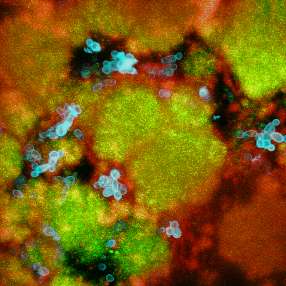Bacterium and fungus team up to cause virulent tooth decay in toddlers

Early childhood caries, a highly aggressive and painful form of tooth decay that frequently occurs in preschool children, especially from backgrounds of poverty, may result from a nefarious partnership between a bacterium and a fungus, according to a paper published ahead of print in the journal Infection and Immunity.
The resulting tooth decay can be so severe that treatment frequently requires surgery—in the operating room, says corresponding author Hyun (Michel) Koo of the University of Pennsylvania.
"Our data will certainly open the way to test agents to prevent this disease, and even more intriguing, the possibility of preventing children from acquiring this infection," says Koo.
In the study the investigators showed that infection by S. mutans and C. albicans together doubled the number of cavities, and boosted their severity several-fold in rats.
Koo, of U. Penn's School of Dental Medicine, has spent 15 years studying how microbes construct the biofilms, also known as plaque, that have plagued teeth since H. sapiens invented agriculture, bringing large quantities of starch into the diet. (Caries are common in Neolithic skeletons, but virtually absent from our Paleolithic ancestors.)
The bacterium Streptococcus mutans has long been assumed to be the sole microbial culprit, but Koo and collaborators—as well as other investigators—noticed that the fungus, Candida albicans, was almost always present in plaque from cases of early childhood caries. S. mutans sticks to the surfaces of teeth by converting sugars to a sticky glue-like material called extracellular polysaccharide (EPS.) In the mouth, Candida adheres mainly to cheek and tongue, but had rarely been seen in dental plaque.
"However, we and others noticed that Candida was very frequently observed in plaque from patients who have early childhood caries," says Koo. "We were puzzled! Candida usually does not associate with S. mutans, nor does it colonize teeth very effectively."
The investigators discovered that the "exoenzyme" which S. mutans uses to react with sugar to produce EPS, also enables Candida to produce a glue-like polymer in the presence of sugar, allowing it to adhere to teeth, and to bind S. mutans, two abilities it otherwise lacks. Under these circumstances, the fungus now contributes the bulk of the plaque.
"The combination of the two organisms led to a greatly enhanced production of the glue-like polymer, drastically boosting the ability of the bacterium and the fungus to colonize the teeth, increasing the bulk of the biofilms and the density of the infection," says Koo. All that led to greatly elevated accumulation next to the teeth of the acid that dissolves enamel, leading to cavity formation.
"This represents a truly unique physical interaction where a bacterially-produced product attaches to and functions on the surface of an organism from another kingdom, converting this normally innocuous (with respect to teeth) fungus into a fierce stimulator of cariogenic biofilm formation," says Koo. That observation, he says, supports his hypothesis that early childhood caries in toddlers results from infection by both organisms, with frequent exposure to sucrose.
More information: A copy of the manuscript can be found online at bit.ly/asmtip0314b . The final version of the article is scheduled for the May 2014 issue of Infection and Immunity.

















